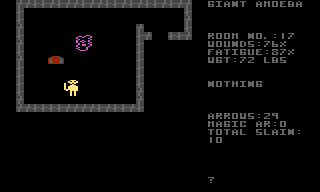
Dunjonquest isn't exactly a well-known name nowadays, but back in the early 80s it rivaled the likes of Ultima and Wizardy in popularity. They're a series of decidedly old school dungeon crawlers, but unfortunately got dropped around 1985 and thus never proliferated likes its peers. This article covers the main Dunjonquest games as well as its spinoffs. I had originally heard of the name from the Atari 400 game Temple of Apshai, which was one of the first RPGs I'd ever played, and what I immediately thought of when I played Diablo years later.
Trace Memory (also known as Another Code in Japan and Europe) is a short series by Cing, who unfortunately went out of business earlier this year. It was one of the first Japanese-style adventure games to hit the DS, and eventually paved way for the likes of Phoenix Wright and Hotel Dusk, the latter also made by Cing. (And also 999: 9 Hours 9 Persons 9 Doors, recently localized by Aksys, and is apparently very good.) Sadly the Wii sequel didn't see release in North America, because we're too impatient to like adventure games, apparently. We also have a review of Catrap, a cute little Gameboy puzzler that sprung from a rather old BASIC computer game called Pitman.
I've also started the first of what I hope to be a series of articles called Total Conversion. Our articles always compare one or two scenes across different versions, but the goal of these articles is to select two drastically different versions, play them to completion, and compare each and every major moment. Here, I've chosen the Genesis version of Ys III and the PSP version of Ys: Oath in Felghana, its remake which was recently released in the US a month or so ago. There's something like at least 70 screenshots from each game, detailing all of the levels, bosses and major story events, so it's pretty exhaustive.
For our Featured Article, we dug up this short piece on Sunsoft Fighter, mostly because the first game featured, Galaxy Fight, was recently released on the PSN courtesy of Monkey Paw Games. It's an alright fighter, nothing terribly special, but it's got a bit of an amusing sense of humor (one of the characters is a Monty Python and the Holy Grail-style killer bunny), and it paved the way for (the superior) Waku Waku 7.

Cing declared bankruptcy but a bigger company willing to fill their $1million debt can still buy them out.
ReplyDeleteStill hoping nintendo buy them, if only so we can get a sequel to little kings story.
Yacopu from Galaxy Fight isn't just a random character. He is the protagonist of Trip World, for the GameBoy.
ReplyDeleteI thought I was an Apshai nut, but this article blows me away with new information! I had no idea about half this stuff. It's funny, what originally got me interested in the series was when Strongbad played Temple of Apshai on his TRS-80 :) But, that version of the game he played was impossible to find! Every few years I'd search for it, and I eventually got the PET version working... but this inspired me to search again and I finally found a TRS-80 version that would run! What really helped was that I finally found helpful tutorials on how to use a TRS-80 (and emulator) and run something. It's hard to use a system you didn't grow up with, and even harder to find people willing to help you with it. The rare Macintosh version really intrigues me, I think that's next on my list so I can get it running on my actual SE :)
ReplyDeleteThe Dunjonquest article is the very embodiment of why I value HG101 so much. On top of that, it gave me the link to The Museum of Computer Adventure Game History - a site I thought had disappeared from the net (I had it bookmarked in its previous form before it disappeared without as much as a forwarding address).
ReplyDeletethanks for the shoutout on Catrap! More appreciated than you know!
ReplyDelete